Losing an arm or a hand is a life-changing experience, but modern prosthetic technology has made it possible to regain movement, independence, and confidence. If you’re looking for an upper limb prosthetic, one of the biggest decisions you’ll face is choosing between a myoelectric and a body-powered prosthetic.
Both types have their advantages, and the best choice depends on your lifestyle, daily activities, and personal comfort. Some people prefer the high-tech functionality of myoelectric prosthetics, while others value the durability and reliability of body-powered options. The right prosthetic should not only restore function but also fit seamlessly into your life.
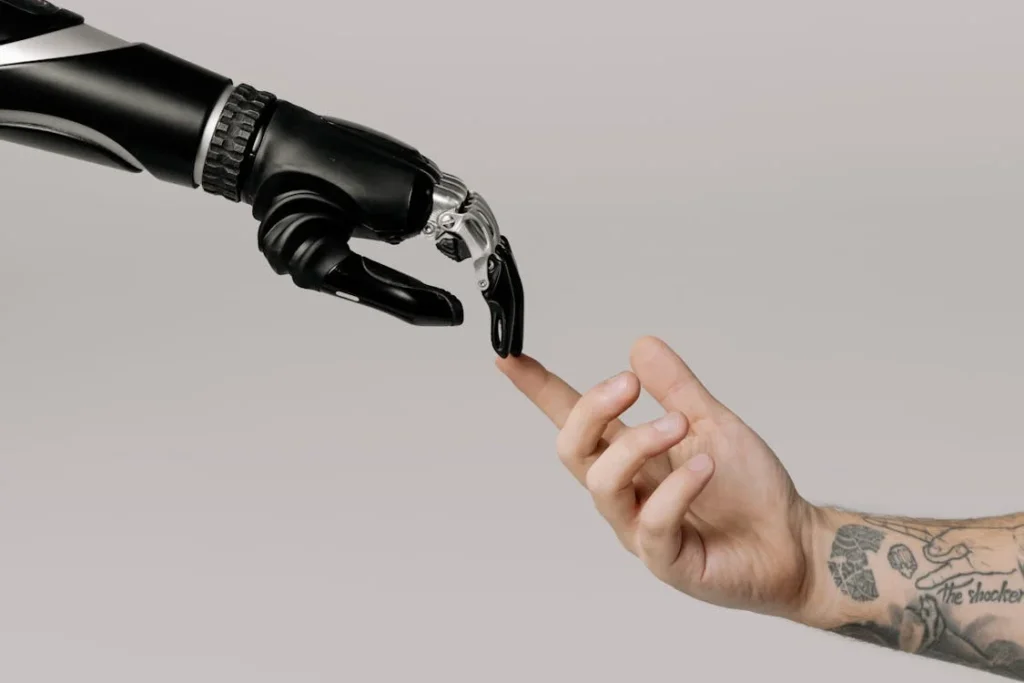
Understanding How These Prosthetics Work
Before choosing between a myoelectric and a body-powered prosthetic, it’s important to understand how each one functions.
The way they operate impacts how natural they feel, how much effort they require, and how well they integrate into daily activities.
How Myoelectric Prosthetics Work
Myoelectric prosthetics are powered by electrical signals from your muscles. Sensors inside the prosthetic socket detect muscle activity in your residual limb and translate those signals into movement.
For example, when you flex a muscle, the prosthetic hand responds by opening or closing. This allows for more natural and intuitive control compared to traditional prosthetics.
One of the biggest advantages of myoelectric prosthetics is that they do not require harnesses or cables. Since they rely on muscle signals, they provide a sleek, modern design and offer a more lifelike experience.
Many advanced models, like Grippy™ by Robobionics, even feature multiple grip patterns, allowing users to perform a wide range of tasks with greater precision.
How Body-Powered Prosthetics Work
Body-powered prosthetics use a system of cables and a harness to control movement. The user activates the prosthetic hand by moving their upper body in a specific way.
For example, by pulling back on a shoulder harness, the cable tightens, causing the hand or hook to open or close.
Because they rely on mechanical force rather than electronic signals, body-powered prosthetics are incredibly durable and require very little maintenance.
They work well in environments where myoelectric prosthetics may not, such as wet, dusty, or physically demanding conditions.
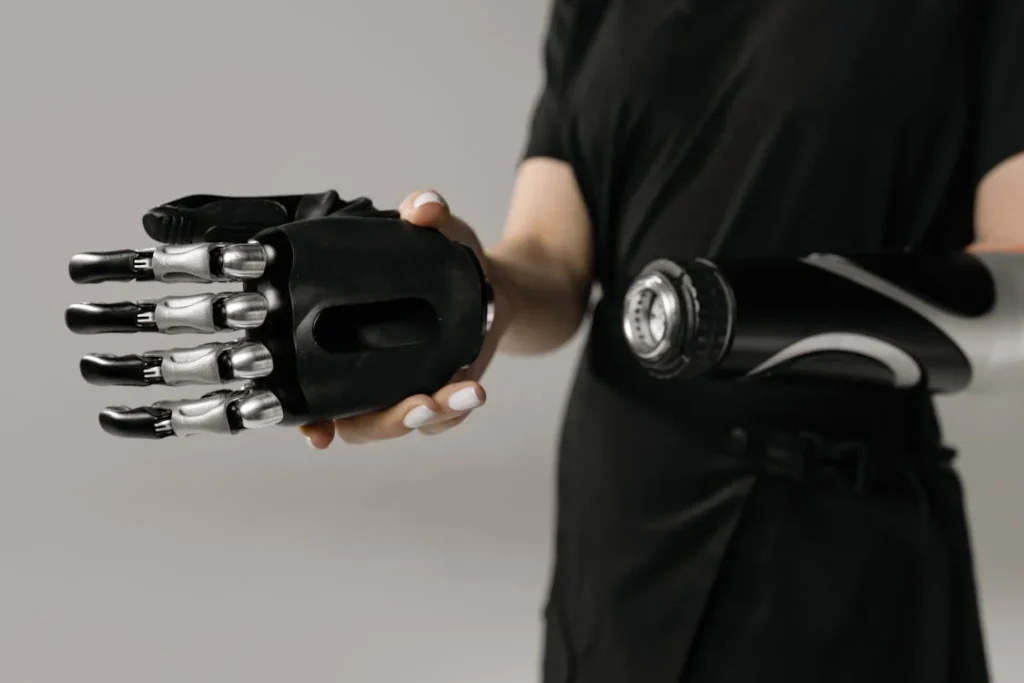
Comparing Functionality and Performance
The choice between myoelectric and body-powered prosthetics often comes down to how they perform in everyday life.
Functionality plays a crucial role in how well a prosthetic integrates into daily routines, work environments, and personal activities.
While both options restore movement, they do so in very different ways, each with unique advantages and limitations.
Strength and Grip Control
One of the biggest differences between myoelectric and body-powered prosthetics is how they generate force. Myoelectric hands use battery-powered motors to control movement, which allows for a stronger and more controlled grip.
The level of force can often be adjusted, making it easier to handle delicate objects like a glass of water or apply enough pressure to hold onto heavier items securely.
Because these prosthetics rely on electrical signals from the muscles, they provide a more natural experience, allowing users to grasp objects without excessive strain.
Body-powered prosthetics, on the other hand, depend on the user’s physical effort to create movement. The grip strength is determined by how much force the user applies through the harness and cable system.
This means that while body-powered prosthetics are effective for tasks that require durability and reliability, they may require more energy to operate over long periods.
Some users find that prolonged use leads to shoulder or back fatigue, especially when performing repetitive actions.
However, for those who prefer a mechanical and highly durable solution, body-powered designs remain a practical choice.
Precision and Fine Motor Skills
Myoelectric prosthetics excel in precision and fine motor control. With advanced technology, these prosthetic hands can mimic the natural movement of fingers, allowing users to perform intricate tasks such as typing, holding utensils, or even handling small objects like buttons and zippers.
Many modern myoelectric prosthetics come with multiple grip patterns, enabling users to switch between different hand positions depending on the task at hand.
This versatility makes them ideal for professionals, students, and individuals who require delicate hand coordination in their daily lives. Body-powered prosthetics, while functional, do not offer the same level of fine motor control.
Most models are designed with a simple open-and-close mechanism, which is effective for general gripping but may not provide the dexterity needed for precise actions. This can make certain tasks, such as writing or using electronic devices, more challenging.
However, some users appreciate the direct control that body-powered prosthetics provide, as they do not rely on electronic components or external power sources.
Adaptability in Different Environments
When it comes to environmental adaptability, body-powered prosthetics have a clear advantage in rugged or physically demanding conditions. Because they do not rely on electronic components, they are resistant to water, dirt, and impact.
This makes them an excellent choice for individuals who work in construction, agriculture, or other outdoor settings where exposure to harsh conditions is common.
Additionally, body-powered prosthetics do not require charging, meaning they are always ready for use without worrying about battery life.
Myoelectric prosthetics, while advanced, require more care in certain environments. Since they rely on battery power and electronic sensors, they are not always suitable for wet or dusty conditions.
While some newer models offer water resistance, prolonged exposure to moisture or debris can still affect their performance. However, for those who primarily work indoors, engage in office tasks, or need advanced grip control for everyday activities, myoelectric hands provide an unmatched level of functionality and ease of use.
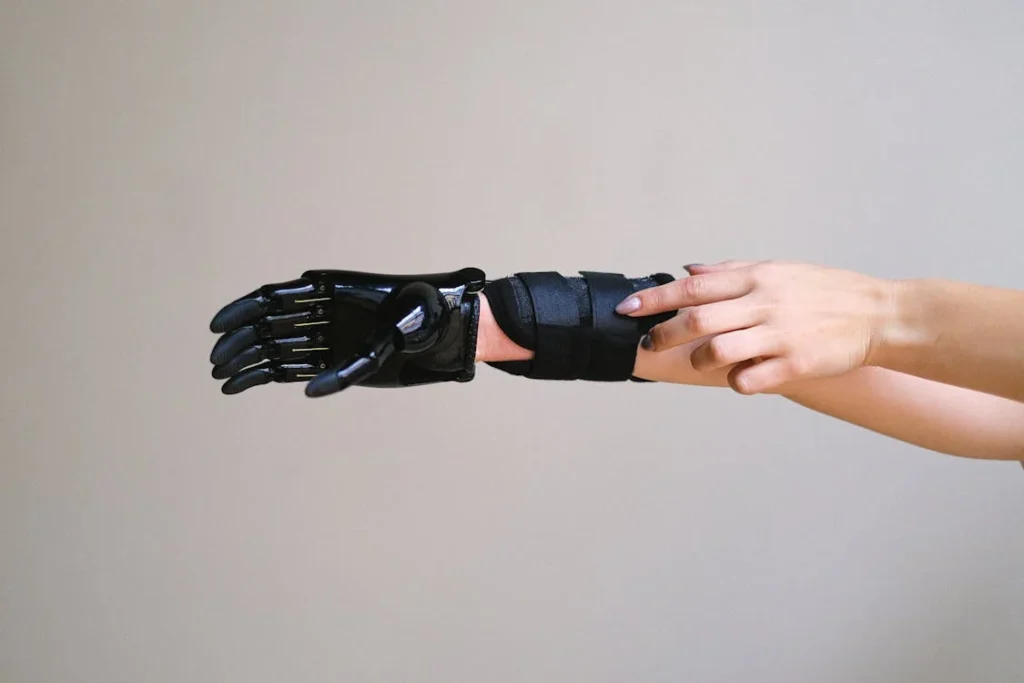
Comfort, Maintenance, and Long-Term Usability
Choosing between a myoelectric and a body-powered prosthetic is not just about functionality—it’s also about comfort and long-term ease of use.
A prosthetic should feel like a natural extension of the body, allowing for smooth movement without causing strain or discomfort. The level of maintenance required also plays a significant role in determining which option is best suited for an individual’s lifestyle.
Comfort and Wearability
The way a prosthetic feels when worn for long hours is a major factor in user satisfaction. Myoelectric prosthetics, being cable-free, offer a more lightweight and streamlined design.
They do not require a harness system, which means less strain on the shoulders and back. Since they function based on muscle signals, they provide a more natural range of motion without requiring large body movements to operate.
For users who prioritize ease of movement and minimal physical effort, myoelectric prosthetics tend to be the more comfortable option. Body-powered prosthetics, however, rely on a harness and cable system that can sometimes feel restrictive.
The harness distributes the control force across the upper body, and for some users, this can lead to discomfort, especially during prolonged use. The tension in the cables requires continuous engagement of the shoulder and back muscles, which may cause fatigue over time.
Some individuals adjust to this feeling and build strength over time, but for those with shoulder issues or limited mobility, this type of prosthetic may not be the best fit.
Maintenance and Durability
When it comes to durability and ease of maintenance, body-powered prosthetics have a strong advantage. Since they operate mechanically without electronic parts, they are highly reliable and resistant to wear and tear.
Users do not need to worry about battery life, sensor malfunctions, or electrical failures. Simple maintenance, such as occasional adjustments to the cable system or minor repairs, ensures that the prosthetic remains functional for years.
Myoelectric prosthetics, while offering advanced functionality, require regular maintenance. Since they rely on electrical components, they need battery charging, software updates, and periodic servicing to ensure that the sensors and motors continue to work properly.
If a component fails, repairs may take longer compared to body-powered prosthetics. However, for many users, the trade-off is worth it because of the increased comfort and precision control that myoelectric prosthetics provide.
Adapting Over Time
For new prosthetic users, the learning curve is an important consideration. Body-powered prosthetics require physical conditioning, as users must get accustomed to engaging their upper body muscles for control.
This can take time, and some users experience muscle fatigue during the adjustment period. However, once mastered, body-powered prosthetics can become second nature.
Myoelectric prosthetics require a different type of learning process. Users need to develop muscle control to activate the sensors correctly, which may take practice.
Rehabilitation programs, like the gamified home-based training offered by Robobionics, help users adapt more quickly by making muscle control exercises engaging and interactive.
Over time, most users find that the intuitive nature of myoelectric control makes it easier to perform daily activities with precision and ease.
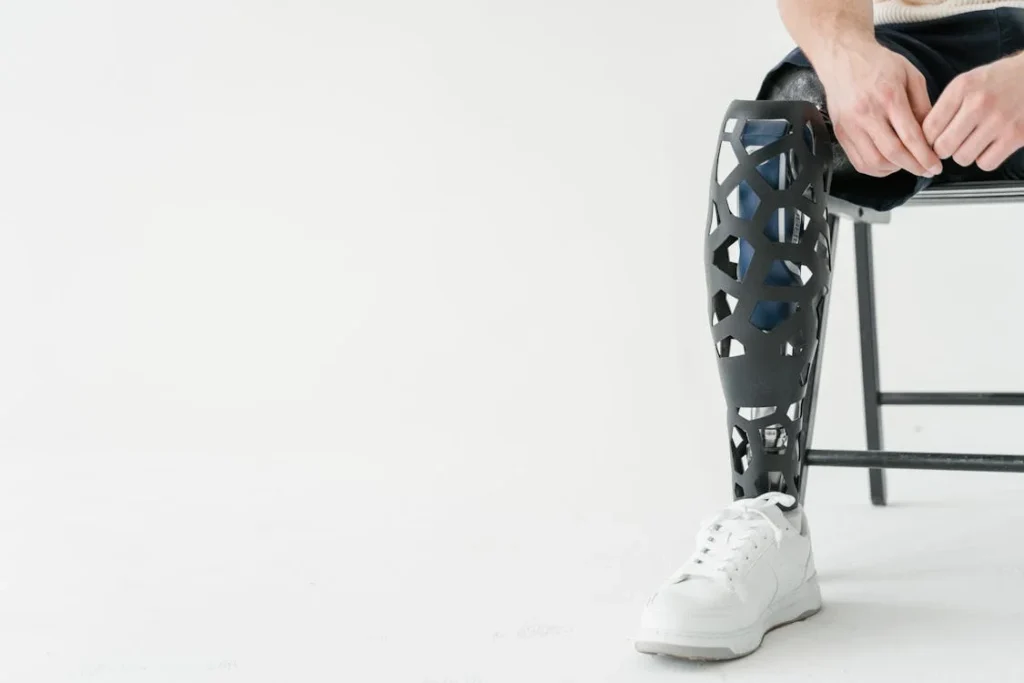
Cost, Accessibility, and Choosing the Right Prosthetic for Your Needs
Beyond function and comfort, cost and accessibility are major factors when deciding between a myoelectric and a body-powered prosthetic.
The investment in a prosthetic limb goes beyond the initial purchase—it includes long-term costs for maintenance, upgrades, and potential replacements.
Understanding these financial and practical considerations can help users make the best decision based on their personal circumstances.
Cost Considerations
Myoelectric prosthetics are typically more expensive than body-powered options. The advanced technology, including sensors, motors, and battery systems, adds to the cost.
Additionally, regular maintenance and occasional repairs may require specialized technicians, leading to additional expenses over time. Despite the higher upfront cost, many users find that the benefits—such as natural movement, multiple grip patterns, and improved aesthetics—justify the investment.
Some insurance providers and government programs may cover a portion of the cost, making these prosthetics more accessible to those who qualify. Body-powered prosthetics are generally more affordable, both in terms of initial cost and long-term maintenance.
Since they use mechanical components instead of electronic parts, they require fewer repairs and replacements. Many users appreciate the simplicity of these prosthetics, as they do not rely on expensive technology to function effectively.
For individuals looking for a cost-effective and durable solution, body-powered options remain a practical choice.
Availability and Support Services
Accessibility also plays a role in deciding which prosthetic is the best fit. Myoelectric prosthetics require specialized fitting, programming, and ongoing support to ensure they function properly.
While urban areas and major healthcare centers often have access to trained professionals who can assist with these prosthetics, users in rural or remote locations may find it challenging to get timely support or repairs.
Body-powered prosthetics, with their simple and mechanical design, can be maintained with minimal professional intervention. Many prosthetists can easily adjust or repair them without requiring high-tech equipment.
For users in areas where specialized prosthetic services are limited, a body-powered prosthetic may be the more practical option.
Finding the Best Fit for Your Lifestyle
Choosing between a myoelectric and a body-powered prosthetic ultimately depends on your lifestyle and priorities. If you work in an office setting, perform tasks that require fine motor skills, or prefer a prosthetic that feels natural and intuitive, a myoelectric prosthetic may be the best choice.
Its advanced grip control and battery-powered movements provide a high level of precision, making daily activities easier and more efficient. If durability, low maintenance, and cost are bigger priorities, a body-powered prosthetic might be the better fit.
Those who engage in physically demanding jobs, outdoor activities, or rugged environments may find that the mechanical reliability of a body-powered prosthetic suits their needs better. The ability to function without batteries or electronic components also makes it a dependable choice for individuals who prefer a straightforward, robust solution.
At Robobionics, we understand that every user has different needs, which is why we offer expert guidance to help you choose the right prosthetic. If you’re unsure about which option is best for you, book a free consultation with our specialists today and explore the best solutions tailored to your lifestyle.
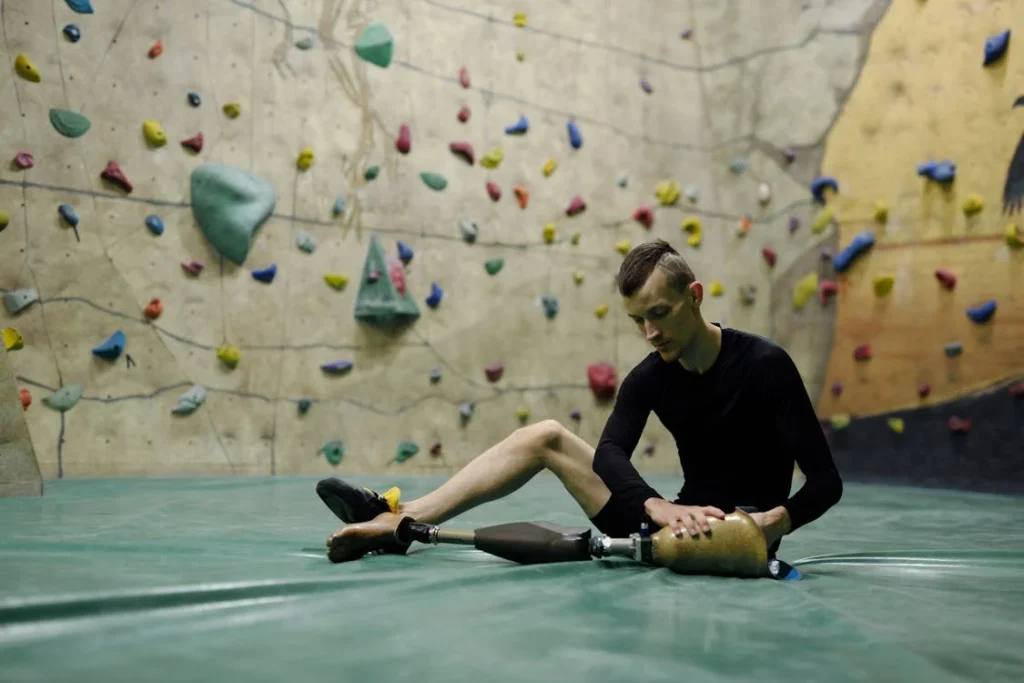
The Emotional and Psychological Impact of Choosing the Right Prosthetic
Beyond the physical and functional aspects of a prosthetic, the emotional and psychological impact is just as important. Adjusting to life with a prosthetic limb is not just about learning how to use it—it’s also about feeling confident, comfortable, and empowered.
The choice between a myoelectric and a body-powered prosthetic can influence how a person views themselves, interacts with others, and regains independence.
Confidence and Social Perception
The appearance and functionality of a prosthetic limb can affect how a person feels in social settings.
Myoelectric prosthetics, with their sleek and advanced design, closely resemble a natural hand, making them a preferred choice for individuals who want a prosthetic that blends into their everyday appearance.
Many modern myoelectric hands even come with lifelike coverings that mimic skin tone, making them less noticeable in public.
For some users, this can make social interactions easier, as they feel more comfortable and less self-conscious. Body-powered prosthetics, especially those with a hook or mechanical hand, have a more functional and industrial look.
Some users embrace this appearance, seeing it as a symbol of resilience and strength. Others may feel more self-conscious about the mechanical design. Ultimately, personal preference plays a big role in whether someone wants a prosthetic that blends in or one that stands out.
Adapting to a New Way of Life
Regardless of the type of prosthetic chosen, the adjustment period can be emotionally challenging. At first, using a prosthetic may feel unnatural, and everyday tasks might seem frustrating.
For individuals who have recently lost a limb, there may also be feelings of grief, frustration, or uncertainty about the future. This is completely normal, and it takes time to develop confidence and skill in using a prosthetic limb.
Myoelectric prosthetics often require mental focus in the beginning, as users must learn to control the hand using muscle signals. This can feel overwhelming at first, but with practice and rehabilitation, control becomes more intuitive.
Gamified training, like the rehabilitation programs offered by Robobionics, can make this learning process smoother by turning muscle training into an interactive experience. Body-powered prosthetics require physical conditioning, as the user must develop strength in their shoulder and back muscles to operate the harness system.
Some individuals find this tiring at first, but with consistent use, they develop the necessary strength and coordination. The key to success is patience and persistence, regardless of which type of prosthetic is chosen.
Support Systems and Community Connection
Having a strong support system can make the transition to using a prosthetic much easier. Friends, family, and rehabilitation specialists play a crucial role in providing encouragement and motivation.
Many individuals also find it helpful to connect with others who have gone through similar experiences. Support groups, both online and in-person, offer a space where prosthetic users can share their experiences, challenges, and successes.
These communities can be a source of inspiration, offering real-life advice on everything from adapting to daily activities to managing emotional well-being. Knowing that others have faced similar obstacles and overcome them can be incredibly empowering.
A New Perspective on Ability and Independence
Many people who use prosthetics find that over time, their perspective on ability shifts. What once seemed like a limitation becomes an opportunity to explore new ways of doing things.
With practice, tasks that once felt difficult become second nature. Whether it’s learning how to tie shoelaces with a myoelectric hand or mastering the strength required to operate a body-powered prosthetic, every small achievement builds confidence.
At Robobionics, we believe that prosthetics are not just about restoring function—they’re about restoring independence, confidence, and quality of life. Every individual’s journey is unique, and finding the right prosthetic is about more than just technology. It’s about choosing a solution that empowers you to live your life fully and without limitations.
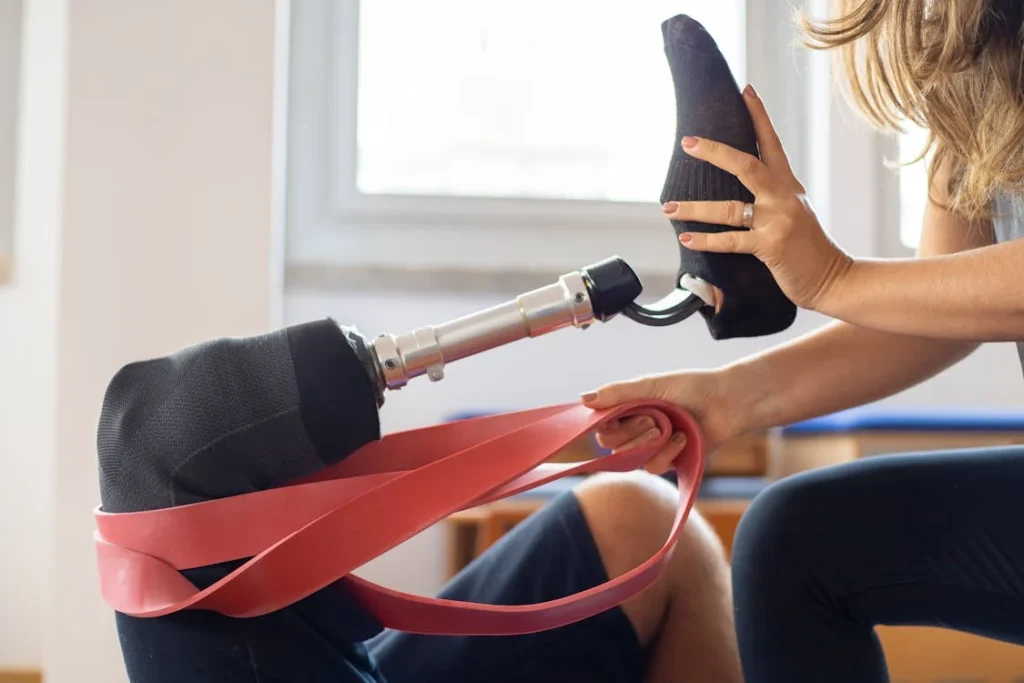
The Role of Rehabilitation and Training in Maximizing Prosthetic Use
Selecting the right prosthetic is only the first step—learning how to use it effectively is what truly determines success. Rehabilitation and training play a crucial role in helping users adapt to their prosthetic limb, whether it’s a myoelectric or body-powered device.
Without proper guidance and practice, even the most advanced prosthetic can feel unnatural or difficult to use. The transition is not just physical but also mental, requiring patience, persistence, and structured training to achieve full functionality.
Building Muscle Strength and Control
For both myoelectric and body-powered prosthetics, muscle control is essential. Myoelectric users must learn how to activate the sensors in their prosthetic using muscle contractions in their residual limb.
At first, this can feel unfamiliar, as the body has to adapt to a new way of sending signals. Regular exercises that focus on strengthening the residual limb and improving muscle coordination are key to making control feel intuitive over time.
Body-powered prosthetic users, on the other hand, rely on upper body strength, particularly in the shoulders and back, to operate the harness and cable system.
Strength training is often necessary to build endurance, as prolonged use can initially cause fatigue. Exercises that target these muscle groups help improve efficiency, making it easier to use the prosthetic for extended periods without discomfort.
Learning Everyday Tasks with a Prosthetic
Adapting to a prosthetic means relearning simple everyday tasks in a new way. Even actions like picking up a cup, buttoning a shirt, or using a phone require adjustment.
Myoelectric prosthetic users benefit from training sessions that focus on fine motor skills and grip control. Since these prosthetics offer multiple grip patterns, users must practice switching between different grips to match the task at hand.
For body-powered users, training focuses on optimizing movement patterns.
Since control comes from shoulder and back motions, users must learn how to engage their body efficiently to minimize strain. Occupational therapists and prosthetists guide users through various tasks, teaching techniques that make daily activities smoother and less physically demanding.
The Importance of Gamified Rehabilitation
One of the most effective ways to improve prosthetic use is through gamified rehabilitation. Traditional therapy exercises can sometimes feel repetitive, making it difficult for users to stay motivated.
Gamified training turns rehabilitation into an engaging experience, using interactive challenges that encourage users to practice movement and control in a fun way. At Robobionics, we incorporate gamified rehabilitation into our prosthetic training programs to make learning more enjoyable.
By turning muscle training into an interactive experience, users can improve their control and coordination without the frustration of traditional exercises. This approach not only speeds up the adaptation process but also helps users build confidence in using their prosthetic in real-world situations.
Psychological and Emotional Support During Training
Rehabilitation is not just about physical skill—it’s also about building confidence. Many users experience moments of frustration during the learning process, especially in the early stages when tasks feel difficult.
Emotional support from therapists, family members, and peer communities can make a significant difference. A positive mindset plays a crucial role in how quickly and effectively someone adapts to their prosthetic.
Encouragement, patience, and celebrating small successes help users stay motivated. Support groups and mentorship programs, where experienced prosthetic users share their journey, can also provide reassurance and guidance.
Long-Term Adaptation and Skill Development
Rehabilitation doesn’t end after the first few months of prosthetic use. As users become more comfortable, they often discover new ways to improve efficiency and integrate their prosthetic into more complex activities.
Advanced training programs help users refine their skills, whether it’s improving typing speed with a myoelectric hand or learning to lift heavier objects with a body-powered prosthetic.
Over time, using a prosthetic becomes second nature. The key is consistent practice and the right support system. At Robobionics, we believe that prosthetic technology is only as effective as the training that comes with it.
That’s why we focus on providing comprehensive rehabilitation programs that empower users to take full control of their prosthetic journey.
Conclusion
Choosing between a myoelectric and a body-powered prosthetic is a personal decision that depends on your lifestyle, work demands, comfort preferences, and long-term goals. Myoelectric prosthetics offer advanced technology, natural movement, and multiple grip options, making them ideal for those who prioritize precision and ease of use. Body-powered prosthetics, on the other hand, provide durability, reliability, and a lower-maintenance solution for users who need a tough, adaptable prosthetic for physically demanding environments.
Beyond the technology, success with any prosthetic depends on proper fitment, rehabilitation, and consistent practice. Adjusting to a prosthetic takes time, but with the right training and support, it can become a natural part of daily life. Emotional adaptation is just as important as physical function, and having a strong support system makes a big difference in confidence and independence.
At Robobionics, we are committed to helping you find the right prosthetic solution tailored to your needs. Whether you are considering a myoelectric or body-powered prosthetic, our experts are here to guide you every step of the way. Book a free consultation today and take the first step toward a more independent future.



